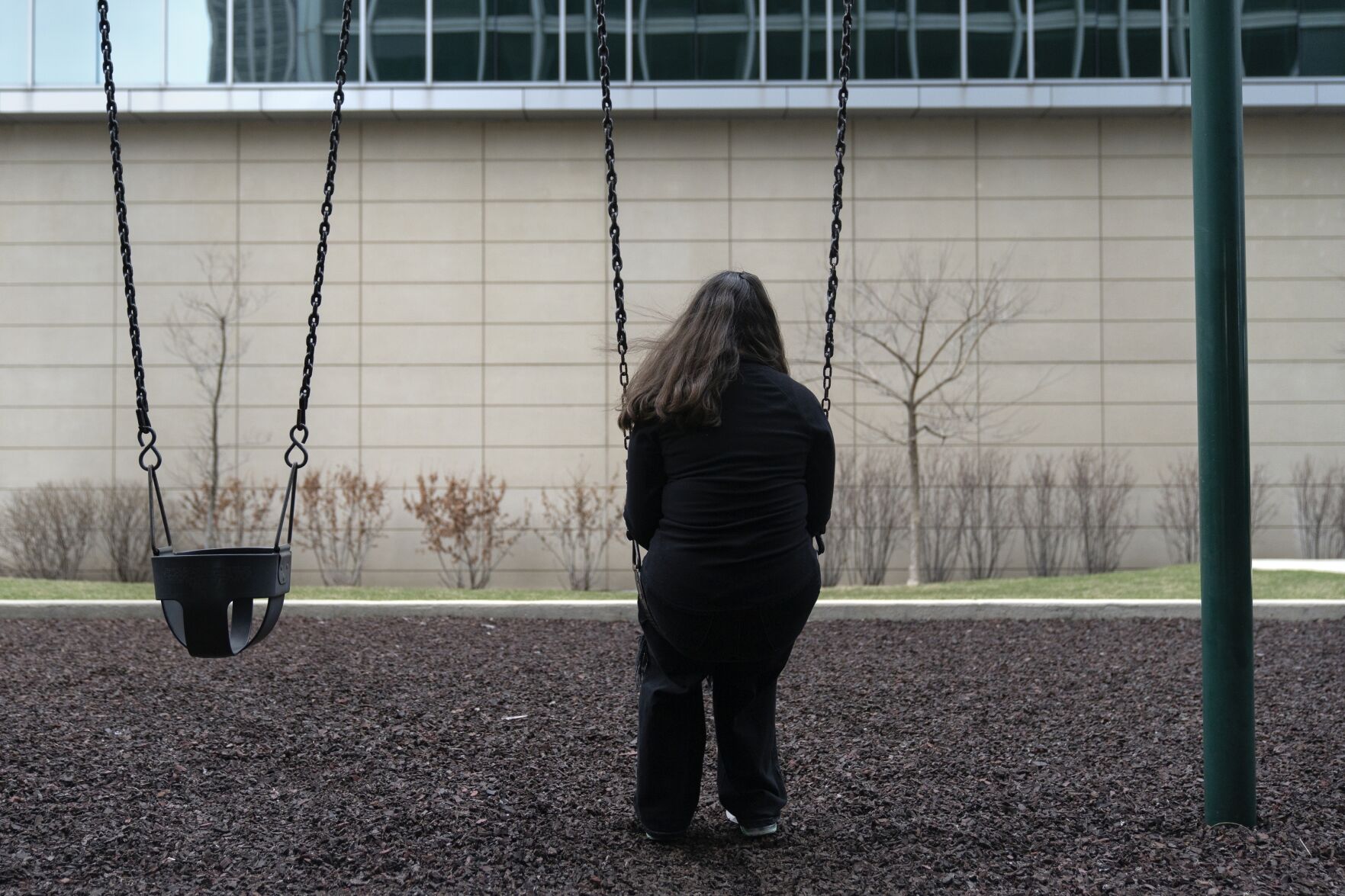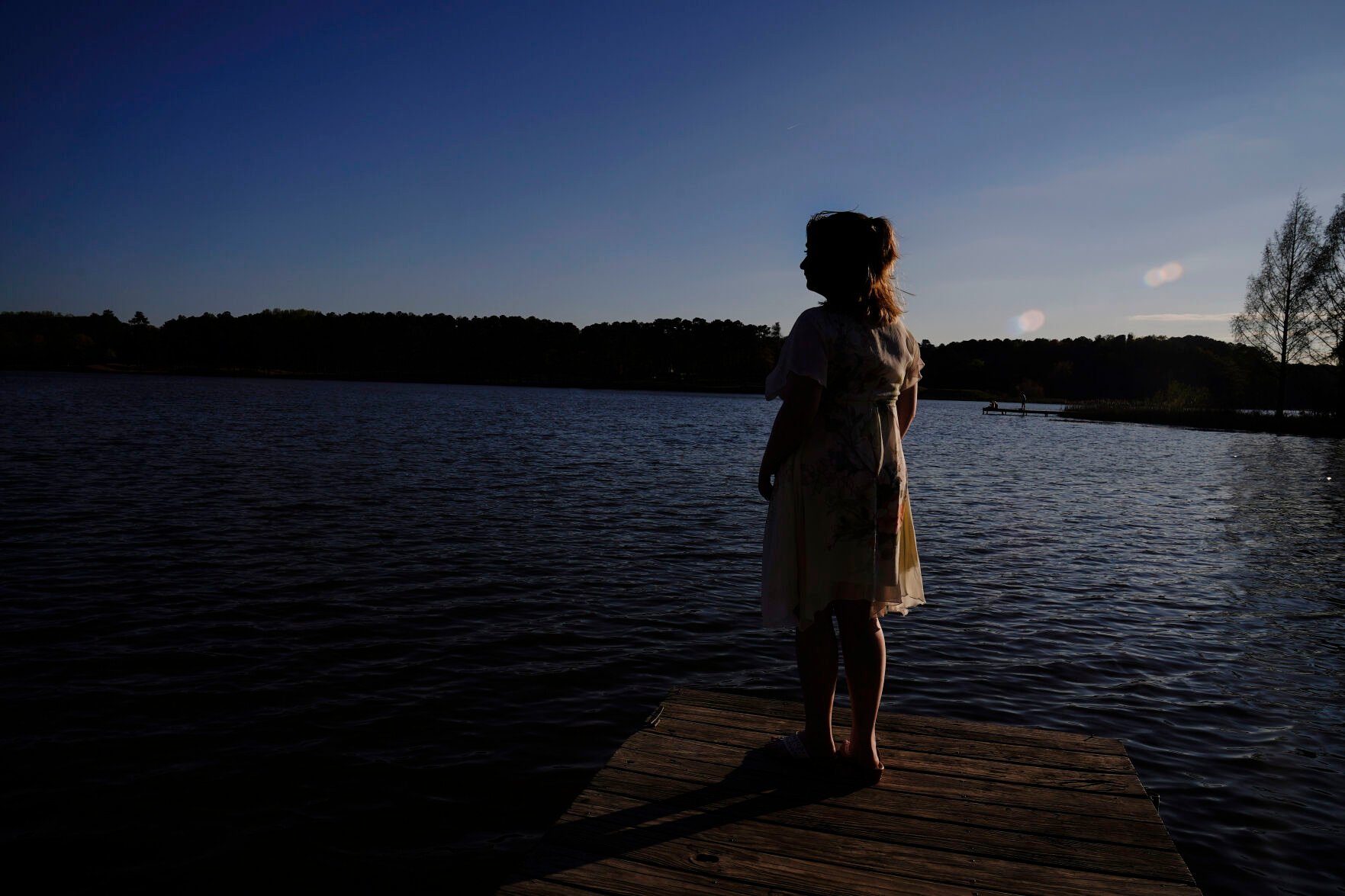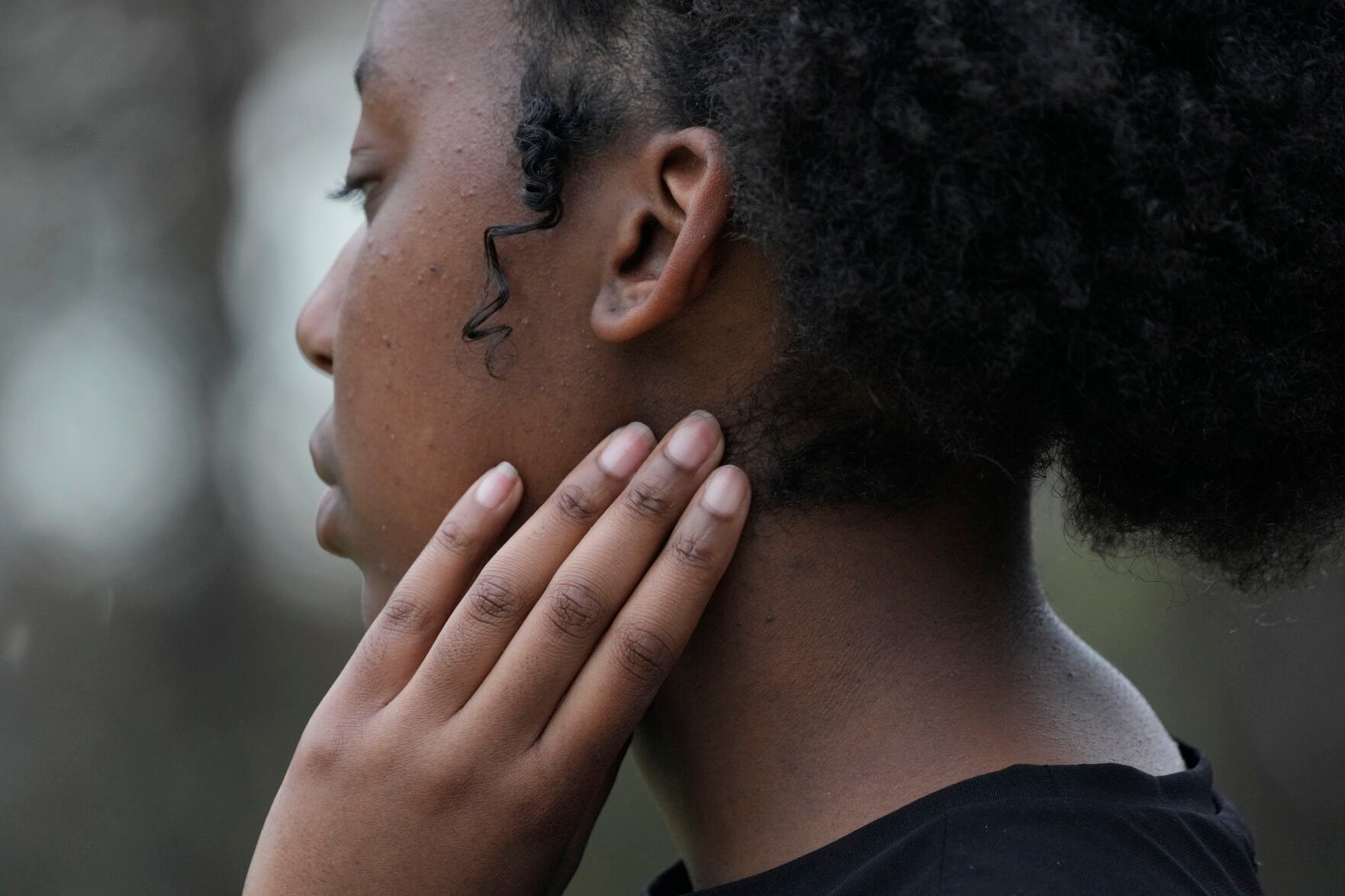Anxiety over academics. Post-lockdown malaise. Social media angst.
Study after study says American youth are in crisis, facing unprecedented mental health challenges that are burdening teen girls in particular. Among the most glaring data: A recent Centers for Disease Control and Prevention report showed almost 60% of U.S. girls reported persistent sadness and hopelessness. Rates are up in boys, too, but about half as many are affected.
Adults have theories about what is going on, but what do teens themselves say? Is social media the root of their woes? Are their male peers somehow immune, or part of the problem?
The Associated Press interviewed five girls in four states and agreed to publish only their first names because of the sensitive nature of the topics they discussed. The teens offered sobering — and sometimes surprising — insight.

Erin Hooley, Associated Press
Amelia, 16, sits for a portrait in a park near her home March 24 in Illinois.
“We are so strong and we go through so, so much,” said Amelia, a 16-year-old Illinois girl who loves to sing and wants to be a surgeon.
She also has depression and anxiety. Like 13% of U.S. high school girls surveyed in the government report, she is a suicide attempt survivor. Hospitalization after the 2020 attempt and therapy helped. But Amelia has also faced bullying, toxic friendships and menacing threats from a boy at school who said she “deserved to be raped.”
More than 1 in 10 girls said they’d been forced to have sex, according to the CDC report, the first increase noted in the government’s periodic survey. Sexual threats are just one of the burdens teen girls say they face.
“We are trying to survive in a world that is out to get us,” Amelia said.
Emma, an 18-year-old aspiring artist in Georgia with attention deficit disorder and occasional depression, says worries about academics and college are a huge source of stress.

Brynn Anderson, Associated Press
Emma, 18, stands for a portrait March 23 in Georgia.
“Lately in myself and my friends, I realize how exhausted everyone is with the pressures of the world and the social issues and where they’re going to go in the future,” Emma added. ”All of these things pile up and crash down.”
Zoey, 15, was raised in Mississippi by a strict but loving single mother who pressured her to be a success in school and life. She echoes those feelings.
“School can be nerve racking and impact your mental health so much that you don’t even … recognize it, until you’re in this space where you don’t know what to do,” Zoey said. She’s also had friendship struggles that ended in deep depression and felt the discomfort of being the only Black kid in class.
Several girls said they face added pressure from society’s standards that put too much focus on how they look.
“A lot of people view women’s bodies and girls’ bodies as sexual,” Emma said. “It’s overwhelming to have all these things pushed on us.”
The #MeToo movement began when these girls were quite young, but it intensified during the pandemic and they’re hyperaware of uninvited sexual advances.
Boys are less aware, they suggest. The girls cite crass jokes, inappropriate touching, sexual threats or actual violence. Girls say the unwanted attention can feel overwhelming.
“We deserve to not be sexualized or catcalled, because we are kids,” Amelia said.
Siya, an 18-year-old in New Jersey, said almost every girl she knows has dealt with sexual harassment. “That’s just been the normal for me,” she said.
“When you’re walking alone as girl, you’re automatically put in this vulnerable situation,” Siya said. “I think that’s so sad. I don’t know what it feels like to not have that fear.”

Rogelio V. Solis, Associated Press
Makena, a high school senior in Mississippi, speaks during a visit April 4 to a community park, a place that brings back happy memories to the 18-year-old.
Makena, a high school senior in Mississippi, said she and her friends sometimes wear baggy clothes to hide their shapes but boys “comment, no matter what.”
She has had depression and therapy, and said she has grown up in a community where mental health is still sometimes stigmatized.
“Often in the Black community we aren’t as encouraged to express emotion” because of what previous generations endured, said Makena, who works with a teen health advocacy group. “We’re expected to have hearts of steel,” she said. “But sometimes it’s OK to not be OK.”
Social media platforms contribute, with their focus on superficial appearances and making perfectionism seem attainable. Girls say they’re just part of the problem.
“Social media has completely shifted the way we think and feel about ourselves” in good and bad ways, Makena said.
She’s felt pressure to be perfect when comparing herself with others online. But she also follows social media influencers who talk about their own mental health challenges and who make it seem “OK for me to feel sad and vulnerable,” she said.
Girls have historically been disproportionately affected by depression and anxiety. But those statistics at least partly reflect the fact that girls are often more likely than boys to talk about feelings and emotions, said Dr. Hina Talib, an adolescent medicine specialist and spokesperson for the American Academy of Pediatrics.
Zoey, the Mississippi 15-year-old, says boys have to keep up a “macho facade” and are less likely to admit their angst.
“I feel like they might feel that way, we just don’t see it,” she said.
A study published in March in The Journal of the American Medical Association found that in 2019, before the pandemic, about 60% of children hospitalized for mental health reasons were girls. A decade earlier, the difference was only slight.
-
Why are teen girls in crisis? It’s not just social media
Canva
Mental health among high school teens is worsening, according to a recent report from the Centers for Disease Control and Prevention (CDC). Between 2019 and 2021, the percentage of high school teens experiencing persistent feelings of hopelessness and sadness increased from 37% to 42%, continuing a decade-long trend of declining mental health among young people.
USAFacts found that 2021 data shows a stark disparity in mental health for teenage girls and LGBQ+ students. (Note: The survey did not have a question assessing gender identity, so the report does not include data on transgender students). Fifty-seven percent of female students and 69% of LGBQ+ students experienced persistent sadness or hopelessness. About 13% of female students and more than 20% of LGBQ+ students in 2021 had attempted suicide in the past year.
Unstable housing and other social and economic factors can significantly impact teens' health and wellbeing. Three percent of students experienced unstable housing in 2021, but a higher percentage of Native Hawaiian/Pacific Islander, American Indian or Alaska Native and Black students had unstable housing, compared to Asian, Hispanic, and white students. LGBQ+ students were also more likely to have unstable housing than their peers.

Canva
Mental health among high school teens is worsening, according to a recent report from the Centers for Disease Control and Prevention (CDC). Between 2019 and 2021, the percentage of high school teens experiencing persistent feelings of hopelessness and sadness increased from 37% to 42%, continuing a decade-long trend of declining mental health among young people.
USAFacts found that 2021 data shows a stark disparity in mental health for teenage girls and LGBQ+ students. (Note: The survey did not have a question assessing gender identity, so the report does not include data on transgender students). Fifty-seven percent of female students and 69% of LGBQ+ students experienced persistent sadness or hopelessness. About 13% of female students and more than 20% of LGBQ+ students in 2021 had attempted suicide in the past year.
Unstable housing and other social and economic factors can significantly impact teens' health and wellbeing. Three percent of students experienced unstable housing in 2021, but a higher percentage of Native Hawaiian/Pacific Islander, American Indian or Alaska Native and Black students had unstable housing, compared to Asian, Hispanic, and white students. LGBQ+ students were also more likely to have unstable housing than their peers.

-
Why are teen girls in crisis? It’s not just social media
USAFacts
Compared to years prior, high school students reported higher rates of nearly all indicators of poor mental health during the second year of the pandemic. Of all racial and ethnic groups, multiracial students most commonly reported having poor mental health.
Teenage girls and LGBQ+ teenagers had the highest rates of persistent sadness or hopelessness during the pandemic. A lack of connectedness in school is one explanation for this disparity.
Male students were more likely than female students to feel close to people at school. The trend was similar for heterosexual students: Straight teens were more likely than their peers to feel close to people at school. According to the report, when students know people at school care about them, their well-being, and their success, it has a long-lasting positive effect.
USAFacts
Compared to years prior, high school students reported higher rates of nearly all indicators of poor mental health during the second year of the pandemic. Of all racial and ethnic groups, multiracial students most commonly reported having poor mental health.
Teenage girls and LGBQ+ teenagers had the highest rates of persistent sadness or hopelessness during the pandemic. A lack of connectedness in school is one explanation for this disparity.
Male students were more likely than female students to feel close to people at school. The trend was similar for heterosexual students: Straight teens were more likely than their peers to feel close to people at school. According to the report, when students know people at school care about them, their well-being, and their success, it has a long-lasting positive effect.
-
-
Why are teen girls in crisis? It’s not just social media
USAFacts
The CDC says quality health education, school connectedness, and establishing a safe and supportive school environment can help address mental health issues, risky sexual behavior, high-risk substance abuse and more. School connectedness helps shape teens' mental, physical, and social growth and lessens risks including drug use and violence.
Creating safe and supportive environments is particularly important for LGBTQ+ students. One example of this is creating gay-straight alliance organizations in schools. The share of schools with gay-straight alliances rose from 23% in 2008 to 40% in 2018, according to the CDC.
Improving access to school-based care and community-based care is another way to support teens experiencing poor mental health. The CDC provides funding to several national nongovernmental organizations which help build the capacity of school districts and schools to identify the needs and issues disproportionately affecting LGBTQ+ youth.
The CDC also recommends implementing science-based, medically accurate health education that is culturally inclusive for LGBTQ+ and minority students. These three strategies are featured in the CDC's "What Works in Schools" research.
To read more on mental health trends for teenagers, see, What are the biggest mental health issues facing young Americans?
USAFacts
The CDC says quality health education, school connectedness, and establishing a safe and supportive school environment can help address mental health issues, risky sexual behavior, high-risk substance abuse and more. School connectedness helps shape teens' mental, physical, and social growth and lessens risks including drug use and violence.
Creating safe and supportive environments is particularly important for LGBTQ+ students. One example of this is creating gay-straight alliance organizations in schools. The share of schools with gay-straight alliances rose from 23% in 2008 to 40% in 2018, according to the CDC.
Improving access to school-based care and community-based care is another way to support teens experiencing poor mental health. The CDC provides funding to several national nongovernmental organizations which help build the capacity of school districts and schools to identify the needs and issues disproportionately affecting LGBTQ+ youth.
The CDC also recommends implementing science-based, medically accurate health education that is culturally inclusive for LGBTQ+ and minority students. These three strategies are featured in the CDC's "What Works in Schools" research.
To read more on mental health trends for teenagers, see, What are the biggest mental health issues facing young Americans?
-
Why are teen girls in crisis? It’s not just social media



